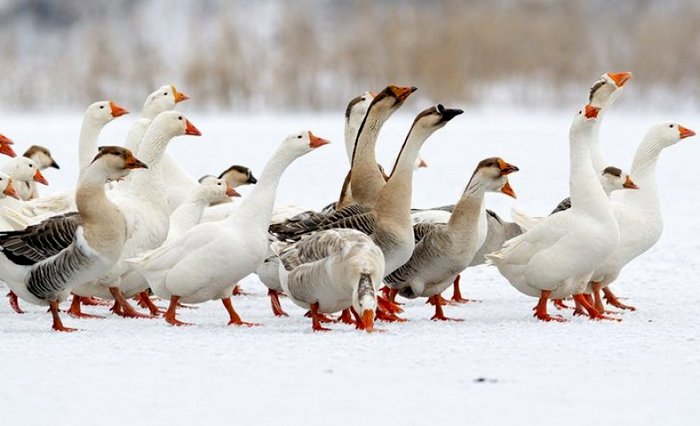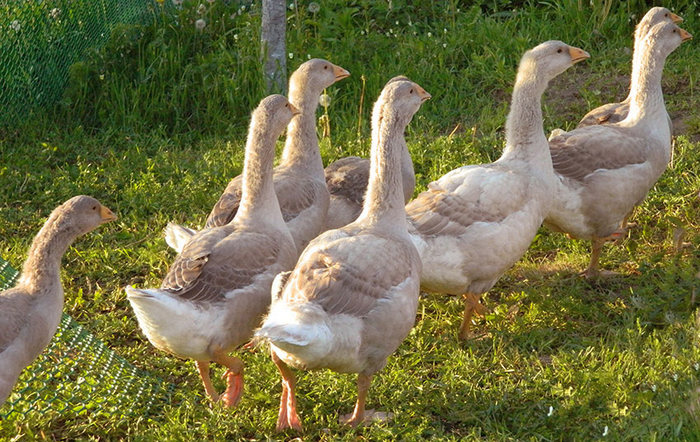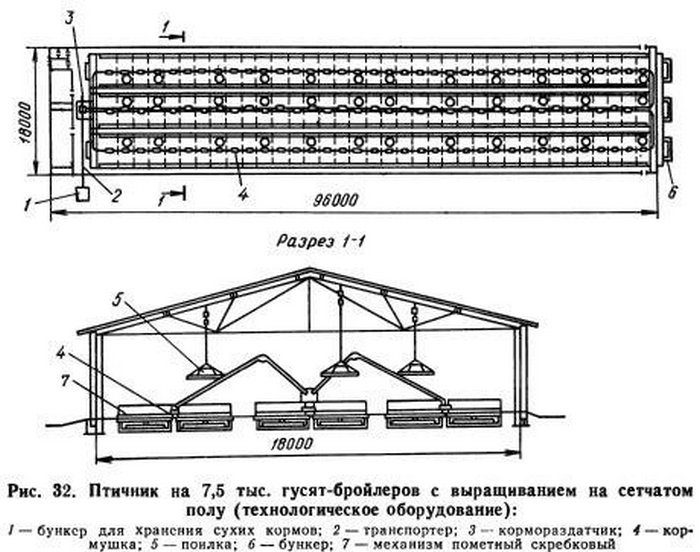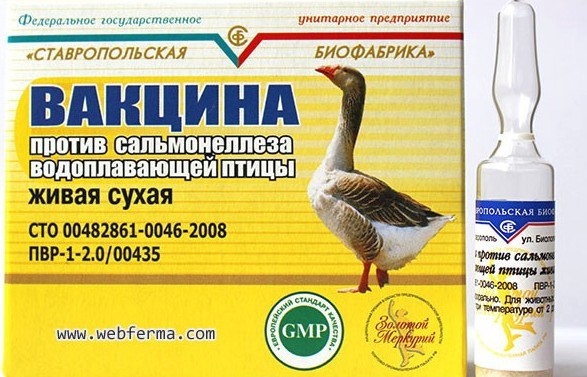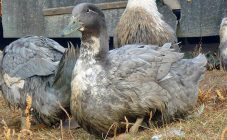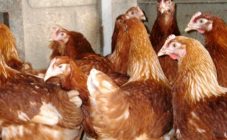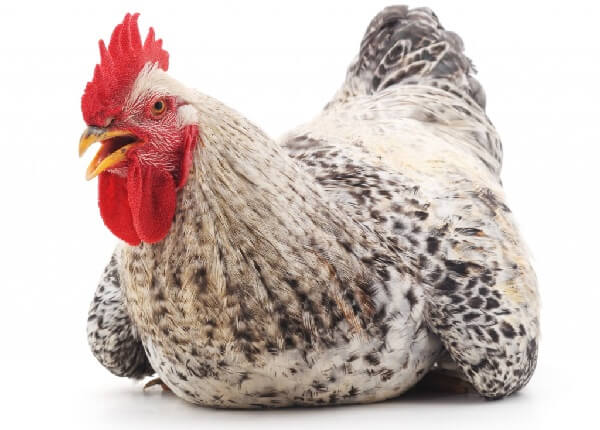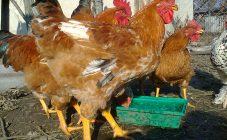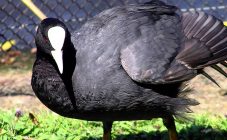Content:
Italian geese are a selection breed that was created with the aim of increasing the productivity of meat. Despite the fact that the goose meat is incredibly tender, it is mostly bred in order to obtain a delicious fatty liver, the mass of which can reach 550-600 g.
History of the breed
A new breed of geese was bred at the beginning of the 20th century in the Apennines, which are located in picturesque Italy. The main goal of crossing a local bird with a Chinese duck was to get the most productive specimen. Thus, the world saw the Italian goose, which was successfully promoted in farmers' markets and gradually became popular in the territory of the Soviet Union. Nowadays, Italian geese can be found in poultry farms in any of the countries of the world, as the birds perfectly adapt to a variety of climatic conditions.
Officially, the Italian breed of bird was presented in 1934 at the Berlin Bird Show. During the event, most visitors wondered if a representative of this breed really saved the Roman Capitol in 382 BC from a fire with a cry. Of course, these are bikes that were launched to spark interest in geese. However, the main feature of the bird is a shrill and loud voice.
There is an eternal debate about the color of the bird that saved Rome from destruction. The famous historian Lucretius argued that the goose was white, and his colleague Cyril, in turn, believed that the goose was silver. Of course, over time, the color scheme of the bird's plumage could change.
Appearance and features
Italian geese are birds of the order of Anseriformes, domesticated by humans for the purpose of breeding for tasty meat. According to the characteristics of the bird, it differs little from other bred species. The Italian goose is naturally endowed with a slightly elongated body, snow-white plumage (another key feature of the breed). Its chest is strong, its neck is large, its beak is short, triangular, and its red-orange paws are dense. The plumage is generally hard, only occasionally turning into down. The wing is long, snow-white. Geese love to cackle and flap their wings during discontent.
Solid white feathers are considered the main sign of the purebredness of the pedigree Italian goose. Individuals that were bred by mixed crosses have a gray tint on their plumage. In addition, the main distinctive characteristics of the breed include:
- large eyes of a bright blue hue;
- a noticeable crest in females, however, the breed characteristics say that this indicator may not always be observed;
- the absence of a lump in the forehead and "purse", which are often present in most of the order of Anseriformes;
- statism in the behavior of birds. Birds are active and mobile. Geese of the Italian breed get along well with each other and make contact with humans. The manifestation of aggression is possible only in cases when a goose appears in the flock, behaving too cocky. The type of behavior can be attributed more to the balanced;
- the head of a goose is small, rather wide with an elongated and flat occipital part, the muscles of the cheeks are pronounced;
- there are no skin folds on the abdomen, it is white, round and deep.
The body weight of an adult female reaches 5.5-6 kg.Male weight is in the range of 6.5-8 kg. Egg production is at a high level. In one cycle, you can expect about 50 eggs, in a couple of cycles, the number reaches 75-80 pieces. The percentage of hatching young animals - 70%.
Males are attentive to their wards. They protect their relatives and do not allow a natural enemy to approach the flock. Females, in turn, do not fulfill their duties very responsibly. The almost complete absence of maternal instincts becomes the reason for the acquisition of incubators in the household for breeding offspring. The Vladimir species of geese, which are considered excellent hens, are suitable as a quota.
If we consider the Italian goose from the point of view of productivity, then any specialist will note that poultry breeding is a promising business. Feathered meat has amazing taste characteristics. Representatives of the Italian goose breed gain weight well and lay a lot of eggs. Due to the softness and density of the plumage, the raw material is actively used in light industry (most often in the manufacture of winter jackets, down jackets). After plucking, you can get at least 90-100 g of down and 200 g of feathers from each goose every 10-12 months.
The Italian variety of geese is ready for slaughter after a few months, since the birds reach commercial size after 2 months of feeding. It is advisable to slaughter before the first molt begins. Compliance with this advice will help maintain the attractiveness of the product (up to 9 weeks you can be sure that there are no "hemp" on the carcass).
For feeding the birds of the Italian breed, you can use the traditional pen-pasture system. A certain percentage of the ration of the poultry is provided by the farmer, and the rest of the food the goose obtains independently when grazing on the lawn.
No description of the breed can convey the gracefulness of restless birds and their restraint in contact with a familiar person.
Features of breeding Italian geese
Many entrepreneurs, deciding to breed Italian geese, are interested in how waste-free production is. In the situation with this breed, profit can be expected from such products:
- meat and fat containing a large amount of vitamins and nutrients in the composition;
- goose liver - a delicacy bought by restaurant owners;
- poultry eggs are a hot commodity;
- goose down and feathers (when you find a wholesale customer, you can get a stable profit);
- sale of young broods (especially wholesale);
- litter is actively purchased by farmers for fertilization.
Chick care
Young chicks do not require complex self-care, however, before purchasing young, you should familiarize yourself withbasic care nuances;
- Up to 6 weeks, small Italian goslings spend the night indoors. After 2 months, they can be safely left in the open air in the garden. In order for them to be able to hide from the rain, it is enough to build a simple canopy.
- It is very important to equip lighting near the feeders and water so that at night the animals can easily find food and drink for themselves.
- It is necessary to teach the bird to get food on its own (in the summer) free-range, and to feed oats exclusively in the evening.
- Systematically solder the birds with medicines that help fight helminths.
Keeping conditions for geese
Italian geese are unpretentious. The main thing when breeding:
- competently equip the poultry house (for winter residence of the bird);
- clean regularly;
- timely vaccinate birds for preventive purposes.
Poultry equipment
Taking into account the activity of geese, it is necessary to allocate for each individual not less than 1 m² of area (average parameter). The permissible building height is between 1.9-2.1 m.
Do not keep geese together with other farm birds or other breeds. Indoor humidity should be within 70%. It is important to provide good ventilation in order to avoid air stagnation, which is the cause of the spread of infectious diseases. It is best to use sawdust or straw for bedding.
Feeding geese
The main food of geese in the summer should be lush green grass, which they can get while free-range. One goose can eat about 1.8-2 kg of grass per day. Fresh greens can increase egg production. In cases where it is not possible to organize a grazing area, poultry feeders should be filled with plenty of greenery every day. In winter, the grass is replaced:
- hay flour;
- root crops;
- oatmeal.
In addition, you need to ensure that the bird feeders always contain:
- corn, oats and legumes;
- sugar beet;
- herbal flour;
- berries (in summer);
- cake;
- feed fat;
- a piece of chalk;
- phosphate without fluoride;
- seashells.
A small thoroughbred gosling, starting from the 6th day of life, can eat:
- grain feed;
- grass;
- wheat bran;
- dry animal feed;
- carrots;
- milk;
- ground shell.
As a drinker, it is better to take galvanized metal troughs, which are installed on metal sheets so that the litter does not get wet. Some are also covered with slats on top - so the birds will not get into them completely to bathe.
Vaccination
To preserve the feathered herd, the livestock should be vaccinated in a timely manner for preventive purposes. In the absence of experience, it is better to seek the help of a veterinarian. On days 3-4, chicks must receive a vaccine against salmonellosis (if the goose was not vaccinated) and on days 9-10 with a vaccinated female. For enteritis, cholera and pasteurellosis, it is better to vaccinate for 14-21 days.
In addition, it is very important to provide systematic prophylaxis against helminths. On the day when deworming is carried out, care should be taken to reduce the feeding of birds. During the day, the bird should be indoors. It is important to change the water every 3-5 hours. The poultry house must also be treated.
It is recommended to add preparations for worms to the bird in the feed early in the morning. For the treatment of helminthic invasion, experts advise using:
- cypophene;
- tetramisole;
- piperazine;
- pyrantel;
- alben.
Breed advantages and disadvantages
TOmain benefits of content Italian geese in comparison with other breeds should be attributed:
- high level of egg fertilization;
- high survival rate of goslings;
- fast weight gain;
- it is easy to get a larger broiler if the female is mated with a heavy goose;
- excellent egg production, which lasts for 5 years;
- delicious meat;
- simple growing of geese;
- the possibility of breeding poultry for the purpose of obtaining meat and for the production of eggs, obtaining feathers, fluff and liver;
- adaptation of birds to a variety of climatic conditions;
- in the absence of a reservoir, the possibility of keeping in a poultry house;
- graceful appearance of birds.
There are also disadvantages:
- the almost complete absence of maternal instinct in geese, which makes it impossible to independently hatch eggs;
- the impossibility of keeping with other breeds of geese.
Italian geese are a godsend for a budding entrepreneur. The absence of difficulties in caring for birds makes it possible to breed poultry even for beginners who are just learning the intricacies of farming. Observing the recommendations and advice of experts, you can get high-quality meat, tasty and weighty liver, as well as delicate down and feathers, which can be easily sold to manufacturers whose field of activity is the manufacture of winter down jackets and jackets.
